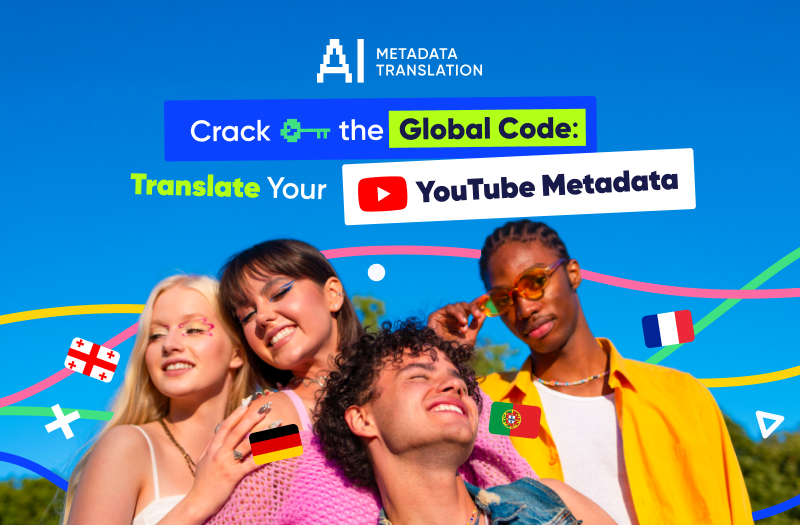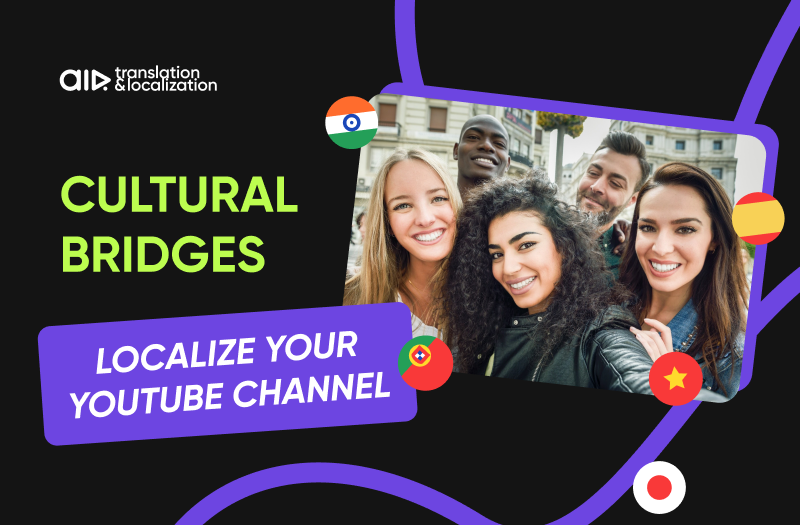Table of contents
01
Why Translate Your YouTube Metadata?
02
How to Translate and Localize Your Titles and Descriptions
03
Tools and Services for Localization
04
Who Gains the Most from Translating YouTube Metadata?
05
Who Might Not Find Metadata Translation as Useful?
06
Best Practices for Localizing YouTube Metadata
07
Benefits of Localized YouTube Metadata
Want More Views? Try Translating Your YouTube Metadata!
Let's talk about how translating and localizing your YouTube metadata can really help your content shine on a global scale. We’ll focus on making your YouTube titles and descriptions more accessible and engaging for audiences who speak different languages. Ready? Let's dive in!
Why Translate Your YouTube Metadata?
Make Your Content Accessible
Translating your video's title and YouTube description allows more people to enjoy your content. Think of it as a welcome mat for viewers who speak different languages.
Expand Your Reach
Localization means your videos can appear in search results for users searching in other languages. Thus, you're not limited to English-speaking audiences.
Boost Engagement
People are more likely to watch and engage with content they can understand. More engagement means higher watch times and better performance overall. Sometimes, viewers who find videos through translated metadata engage more with the content than those who find it through the original metadata language. There may be several reasons for this, one of which is that your type of content or niche is more popular in regions with this language.
Disclaimer: metadata translation is not for everyone. If your content is not understandable without voice acting, consider a comprehensive approach to content translation: metadata, subtitles, and dubbing. For more detailed insights and professional help with these services and the localization of your YouTube metadata, contact AIR Media-Tech. We can help you optimize your content for global audiences.
Improve Your SEO
Localized metadata can help your videos get discovered by a global audience, which boosts your SEO rankings.

How to Translate and Localize Your Titles and Descriptions
Using YouTube Studio
- Sign in to YouTube Studio
Get started by logging into your YouTube Studio account. - Select Subtitles from the Menu
On the left-hand side, click on 'Subtitles'. - Choose Your Video
Pick the video you want to translate. - Add Language
If you haven’t already, choose your video’s original language and confirm. - Add Translations
Click 'Add language', select the language you want to translate, and then add the translated title and description. Hit 'publish' to save your changes.
Making Money on YouTube But Want More?
Let us audit your channel and help you boost those numbers!
Using CSV Files
- Download the Template
Head to the Content Delivery Templates page and download the 'Video - Localization Update' template. - Fill Out the Template
Enter your translated data in the template and save it as a .csv file. - Upload the File
In Content Manager, click 'Validate & Upload' under CONTENT DELIVERY, select your .csv file, and upload it. - Process the Package
Once your file is uploaded and validated, click 'Process package'.
Tools and Services for Localization

Manual Translation
The manual translation of YouTube metadata is accurate and culturally relevant, though it can be time-consuming and costly. Of course, you can translate metadata manually. However, there is one significant drawback to this method. Let's imagine that you have 200 videos on your channel. Let's say you want to translate 50 of them. If you choose only 5 of the most popular languages and spend 10 minutes on each video, that's 2500 minutes of your time. And if it takes even longer and you want to use the full language potential for your content, it will result in days of manual routine work. That's why it's worth looking at automated tools.
Automated Tools
Automated YouTube metadata localization tools are faster. They're great for bulk translations and can be followed with manual edits for better accuracy.
AIR Media-Tech offers a comprehensive service for YouTube metadata translation using AI. Creators can easily add their channel, select the videos they want to translate, and choose the languages. The system will automatically translate and localize the content into all the selected languages, and these translations will then be automatically added to the channel. A trial version is available, offering the first 100 translations for free.
However, if your content requires more than YouTube metadata translation, we recommend consulting with our experts to develop a more robust strategy tailored to your needs.
AIR Translate service is proud to be YouTube's top pick for translation and localization. We'll transform your content into over 50 languages, making it perfect for local audiences everywhere. Reach out to us, and let's make your content global, boosting your earnings along the way!
Who Gains the Most from Translating YouTube Metadata?
If your content is visually driven and doesn’t rely much on spoken words, you're in the sweet spot! Here’s who stands to gain the most:
- DIY and How-to Channels
If your videos show step-by-step instructions that are easy to follow just by watching, this is perfect for you.
- Travel and Nature Channels
Stunning visuals and universal themes make your content a breeze to understand, regardless of language.
- Fitness and Workout Channels
Demonstrations where you show more and talk less are ideal candidates.
- Cooking Channels
Recipe videos where viewers can follow along just by watching the cooking process.
- Art and Craft Channels
Creative demonstrations that speak through visuals rather than words.
Who Might Not Find Metadata Translation as Useful?
You might not see as much benefit if your content leans heavily on spoken words and verbal nuances. Here are some examples:
- Educational Channels
The translation might miss some finer details if your content involves complex explanations or specific terminology.
- News Channels
Programs that need a clear understanding of spoken content and cultural context might find translations lacking.
- Talk Shows and Podcasts
Conversations and verbal interactions don’t always translate well.
- Comedy and Entertainment Channels
Humor, wordplay, and cultural references can be tricky to translate accurately.
- Storytelling and Drama Channels
Narratives that rely on language and voice acting to convey emotions and plot might lose their impact.
In these cases, the nuances of spoken content might not come across effectively, which could lead to misunderstandings or a drop in viewer engagement.
Best Practices for Localizing YouTube Metadata
- Use Simple and Clear Language
Avoid complex phrases and idioms that might not translate well.
- Consider Cultural Nuances
Make sure your translations are culturally appropriate for your target audience.
- Optimize for SEO
Use popular keywords in the target language to improve searchability.
- Maintain Consistent Branding
Ensure your brand voice remains consistent across different languages.
Benefits of Localized YouTube Metadata
- Higher Engagement Rates
Viewers are more likely to engage with content they understand.
- Increased Watch Time
Localized content can keep viewers watching longer.
- Better Monetization
More viewers and higher engagement can lead to better monetization opportunities.
- Competitive Advantage
Localization gives you an edge in the global market.

Translating and localizing your YouTube metadata is a powerful way to grow your channel and reach a global audience. For more detailed insights and professional help, check out AIR Media-Tech. We can help you optimize your content for viewers worldwide, ensuring your videos reach their full potential.





